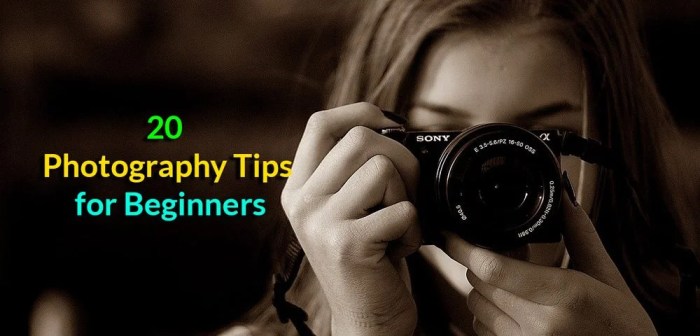Photography Tips for Beginners takes center stage, inviting readers into a world of creativity and skill. Get ready to dive into the essentials of capturing stunning moments through the lens.
Whether you’re just starting out or looking to refine your skills, these tips will pave the way for you to elevate your photography game. From equipment essentials to editing techniques, this guide has got you covered.
Introduction to Photography Tips for Beginners
Photography is the art of capturing images using a camera, and it plays a crucial role in how we document our lives and the world around us. It allows us to freeze moments in time, express our creativity, and share our perspectives with others. Learning photography skills can be incredibly beneficial for beginners as it opens up a whole new world of possibilities and allows for self-expression in a unique way.
The Benefits of Learning Photography Skills
- Improves Observation Skills: Photography encourages you to pay attention to details and appreciate the beauty in everyday life.
- Enhances Creativity: It challenges you to think outside the box and find unique angles and perspectives to capture stunning images.
- Preserves Memories: Photographs serve as visual reminders of special moments and experiences, allowing you to relive them whenever you want.
- Boosts Confidence: Mastering photography skills can build your self-esteem as you see improvement in your work and receive positive feedback from others.
Photography as a Creative Outlet
Photography is not just about taking pictures; it’s about telling a story, conveying emotions, and expressing your vision. For beginners, picking up a camera can be a therapeutic and fulfilling experience, providing a medium to channel your thoughts and feelings into tangible images. Whether you’re capturing landscapes, portraits, or abstract compositions, photography offers endless possibilities for creative exploration.
Essential Equipment for Beginner Photographers
As a beginner in photography, having the right equipment is crucial to capturing stunning images and improving your skills. Here are some must-have camera gear for beginners and their importance:
1. Camera Body
The camera body is the core of your photography gear. For beginners, a DSLR or mirrorless camera is recommended due to their versatility, ease of use, and ability to capture high-quality images. These cameras allow you to adjust settings manually and experiment with different shooting modes, making them ideal for learning the basics of photography.
2. Lenses
Investing in a good quality lens is essential for achieving sharp and detailed images. A standard zoom lens (18-55mm) is a great starting point for beginners as it offers a versatile focal range for capturing a variety of subjects. Consider adding a prime lens (50mm) for portrait photography and a telephoto lens for shooting distant subjects.
3. Tripod
A tripod is indispensable for stabilizing your camera and reducing camera shake, especially in low light conditions or when shooting long exposures. It allows you to capture sharp images without the risk of blurriness, making it an essential tool for landscape, night, and macro photography.
4. Memory Cards
Having spare memory cards is essential for storing your images and ensuring you never run out of storage space while shooting. Opt for high-speed, high-capacity SD cards to accommodate large file sizes and continuous shooting.
5. Camera Bag
A good quality camera bag is necessary for protecting your gear while on the move. Look for a bag that is well-padded, water-resistant, and provides ample space for your camera body, lenses, accessories, and personal items.
6. Lens Cleaning Kit
Keeping your lenses clean is crucial for maintaining image quality. Invest in a lens cleaning kit that includes a lens cloth, lens brush, lens cleaning solution, and air blower to remove dust, dirt, and smudges from your lenses.
7. Camera Strap
A comfortable camera strap is essential for carrying your camera around securely and preventing accidental drops. Opt for a padded strap that distributes weight evenly and provides extra support during long shooting sessions.
8. External Flash
An external flash is useful for adding extra light to your scenes, especially in low light situations or when shooting portraits. It allows you to control the direction and intensity of light, resulting in more creative and professional-looking images.
9. Camera Remote
A camera remote enables you to trigger the shutter without touching the camera, reducing the risk of camera shake and allowing you to capture sharp images, especially during long exposures or self-portraits.
Basic Photography Techniques
Capturing great photos goes beyond just having the right equipment. Understanding basic photography techniques is essential for beginners to elevate their skills and create stunning images.
Rule of Thirds in Composition
The rule of thirds is a fundamental principle in photography composition. Imagine breaking an image into nine equal parts using two horizontal and two vertical lines. The rule suggests placing key elements along these lines or at their intersections to create a visually appealing and balanced composition.
Controlling Exposure Settings
To control exposure settings effectively, you need to understand how aperture, shutter speed, and ISO work together.
– Aperture: Adjusts the size of the opening in the lens that allows light to pass through. A lower f-stop (wider aperture) results in a shallower depth of field.
– Shutter Speed: Determines how long the camera’s shutter remains open to allow light to reach the sensor. A faster shutter speed freezes motion, while a slower speed creates motion blur.
– ISO: Sets the sensitivity of the camera sensor to light. A lower ISO is ideal for bright conditions, while a higher ISO is used in low light situations.
Tips for Framing and Perspective
– Experiment with different angles and perspectives to add depth and interest to your photos.
– Use leading lines to draw the viewer’s eye towards the main subject.
– Consider framing your subject with elements in the environment to create a sense of context and storytelling in your photos.
Lighting Tips for Beginners

When it comes to photography, lighting plays a crucial role in capturing the perfect shot. Whether you’re using natural light or artificial light, understanding how to manipulate and work with light can make a significant difference in the outcome of your photos.
Natural Light vs. Artificial Light
- Natural light: Utilizing natural light can create a soft and flattering look in your photos. The golden hour, which occurs during sunrise and sunset, provides a warm and beautiful light that enhances the mood of your photographs.
- Artificial light: Artificial light sources like studio lights or flash can be used to create more controlled lighting conditions. This type of lighting is excellent for indoor shoots or when natural light is not available.
Enhancing Mood with Lighting
- Lighting can set the tone and mood of your photograph. For example, soft, diffused lighting can create a romantic and dreamy atmosphere, while harsh lighting can convey a sense of drama or intensity.
- Experiment with different lighting angles and intensities to evoke the desired emotions in your photos.
Avoiding Harsh Shadows and Achieving Balanced Lighting
- To avoid harsh shadows, position your subject in a way that the light source is not directly overhead. This can help create a more even and balanced lighting across your subject.
- Consider using reflectors or diffusers to soften harsh light and fill in shadows. Reflectors bounce light back onto your subject, while diffusers help to scatter and soften the light for a more pleasing effect.
Composition and Framing
When it comes to photography, composition and framing play a crucial role in creating visually appealing and impactful images. Understanding different composition techniques can take your photos to the next level and help you tell a compelling story through your lens.
Leading Lines
Leading lines are a powerful compositional tool that guides the viewer’s eye through the image towards the main subject. These lines can be anything from roads, fences, or even shadows that lead the viewer’s gaze and create a sense of depth in the photograph.
Symmetry
Symmetry is another composition technique that can add balance and harmony to your photos. By placing your main subject along the central axis of the frame, you can create a sense of order and stability that is visually pleasing to the viewer.
Framing, Photography Tips for Beginners
Framing is a technique where you use elements in the foreground to frame the main subject of your photo. This can add depth and context to your image, drawing the viewer’s attention to the subject while also providing a sense of place.
Examples of Composition in Action
Remember, good composition can make an ordinary scene extraordinary, while poor composition can ruin even the most interesting subjects.
Rule of Space
The rule of space refers to the amount of empty space in front of the main subject in the direction they are looking or moving. By giving your subject space to “move” within the frame, you can create a sense of movement and balance in your composition.
Editing Tips for Beginners

When it comes to photography, editing plays a crucial role in enhancing the quality of your photos. Basic editing software and tools are essential for beginners to improve their photography skills and make their images stand out.
Introduction to Editing Software and Tools
- Adobe Lightroom: A user-friendly editing software with a wide range of tools for adjusting exposure, color, and sharpness.
- Adobe Photoshop: Ideal for more advanced editing techniques such as layers and masking.
- Snapseed: A mobile editing app with powerful tools for quick and easy adjustments.
Importance of Post-Processing
Editing allows you to correct exposure, adjust colors, and enhance details that may not have been captured perfectly in-camera.
Step-by-Step Editing Tips
- Adjust Exposure: Use the exposure slider to brighten or darken your image for the desired look.
- Enhance Colors: Utilize the vibrance and saturation tools to make colors pop without looking artificial.
- Sharpen Details: Apply sharpening to enhance the clarity and sharpness of your subject.
- Crop and Straighten: Crop your image to improve composition and straighten any crooked horizons.
- Remove Distractions: Use the healing brush or clone tool to eliminate any unwanted elements in your photo.